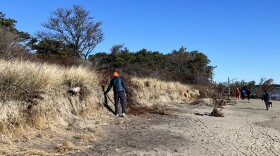About 20 people gathered in a church in Woodstock in late December as it got dark. They had spent the day walking and driving and looking out kitchen windows searching for birds in a big circle that covers most of Woodstock and Bridgewater, and parts of Plymouth and Killington.
They were part of a community science project called the Christmas Bird Count. It’s a tradition that started over a hundred years ago, as an alternative to hunting birds during the holidays. The project is run through the National Audubon Society and relies on thousands of volunteers, all over the country, to record every bird they see or hear within a set 15-mile circle over 24 hours. Scientists use the data to track how different species are doing.
In Woodstock, the count ends with a turkey dinner. It’s been that way for decades.

“Some counts just go home and then they do it from the written forms, but it’s not nearly as much fun as to have everybody together,” said Sally Laughlin. She started the Christmas Bird Count in Woodstock 50 years ago and has been organizing it ever since.
"We're all doing it because we care deeply about birds and we want to collect that data," she said.
"You don't get up at 7 o'clock in the morning and spend the whole day stomping around outside, freezing to death or getting soaking wet, unless it's something you're really committed to," she said with a laugh.

These days, the count is something of a reunion. Like for Tii McLane and Kyle Jones of Strafford.
“Yeah, we like the group. We like the bird geeks,” said McLane.
“Some of us, we run into each other frequently.” said Jones. “Others, this is the only time of the year that we see each other.”
Ed Hack has been part of the Woodstock count since its beginning.
"It’s fun," he said. "That’s why I started in the first place — it’s a great source of enjoyment."
He helped draw the original circle with Laughlin, using glued together U.S. Geological Survey maps and string.
A lot has changed since then. No more sending letters to coordinate volunteers. There are fewer bird feeders in the villages, and more seasonal homes. Some of the birds are different too: fewer black ducks and evening grosbeaks, more tufted titmice and Carolina wrens.

As the original birders have gotten older, they’ve adapted.
“I can’t do it like I like to do, but that’s the name of the game. Things happen,” said Hack. “This works well for me though because I can do it from the car, or a roadside, or from my kitchen window.”
And there are some new faces.
“My plan is for this to be our family’s Christmas tradition,” said Holly Henderson, of Quechee. She brought her husband and two young kids to the potluck dinner.
“We’re probably going to be permanent residents in this area for the rest of our lives," she said. "So we’re going to be doing this for decades, I hope."

Laughlin won’t be leading the event in the decades to come. She’s retiring after this year.
“I don’t know if there’s any other human being on the planet that has coordinated or compiled a Christmas Bird Count for 50 years,” said Chris Rimmer, an ornithologist who will be taking over organizing next year. “It’s an extraordinary accomplishment.”
The group celebrated Laughlin with a card and a cake, decorated with a printed picture of her working at a desk, with a baby great horned owl sitting on her lap. The bird lived at her house in Woodstock while she ran a nonprofit called the Vermont Institute of Natural Science, or VINS.
And while Laughlin won’t be running the show, next year, the turkey dinner will remain. And so will the business at the end of the evening — a countdown of the species different birding groups in the circle saw that day.
This year the group counted 2,423 birds of 39 species.
Have questions, comments or tips? Send us a message.




